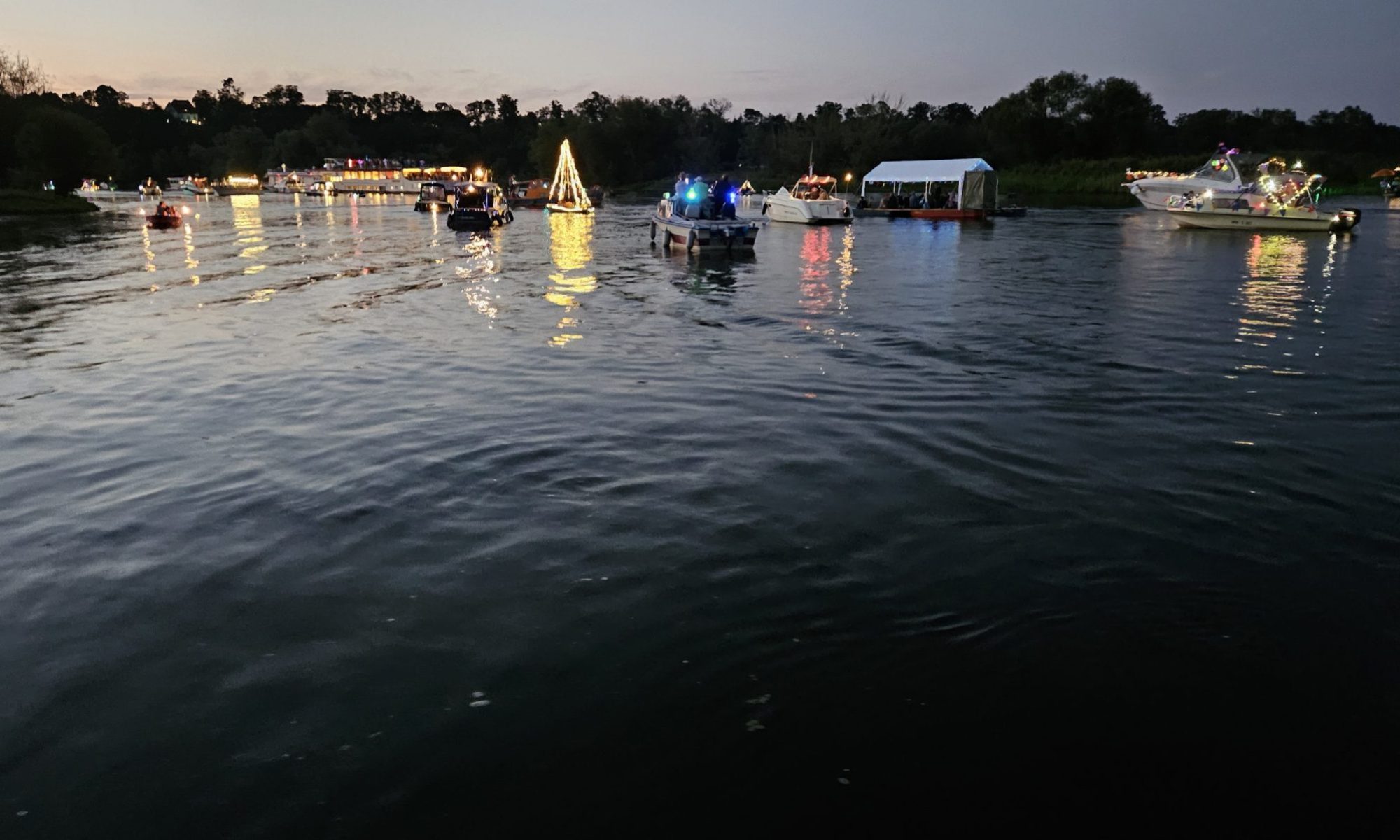Utopienale III: Carrying civilization forward into the future

by Azby Brown
What is essential to civilization? Does human civilization have a future, or are we nearing its collapse? Are there aspects of civilization worthy of greater attention than others as we decide what ideas, tools, and values should be carried forward? How, exactly, is civilization transmitted? What is the potential of art for enabling the kinds of attitude shifts that counteracting our ongoing crises seems to require?
Utopienale III: Carrying civilization forward into the future set out to encourage these questions. Part colloquium, part art festival, part floating conference, the late summer event brought creators, researchers, activists, and students together at the Old School ICA in Haverlberg, Germany, for several days of structured and unstructured conversation and collaboration. A summary exhibition generated around key emergent ideas and contributions is currently on view at the Old School.
Utopienale III had several interwoven primary components:
1) A floating conference and colloquium
2) A boat performace
3) A summary exhibition at the Old School
In addition several creative workshops and talks were held with students and others in the area.
(Promotional material can be seen here)
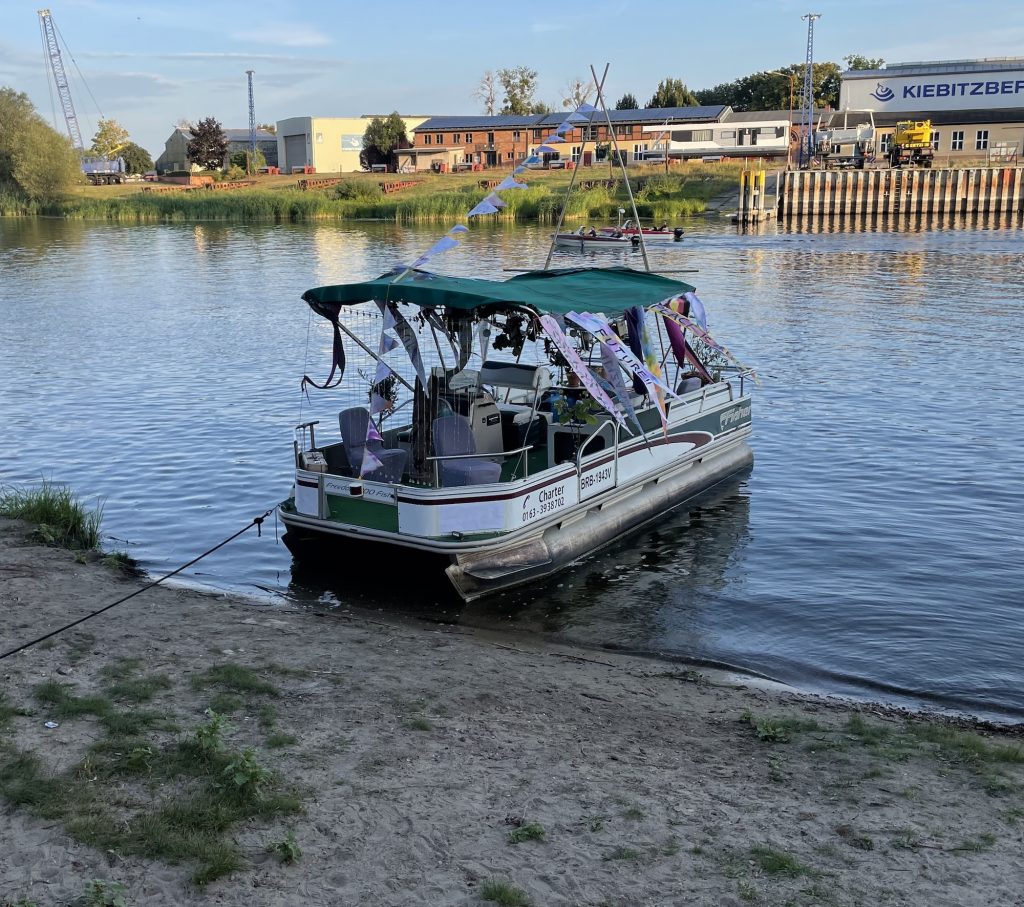
The focus was not on the causes and predictions of collapse themselves, for which a broad literature already exists. Destructive human impacts and institutional behavior were impossible to ignore, though, and were heatedly discussed, and creatively addressed. Participants were encouraged, however, to visualize possible paths forward and to envision positive action, possibly re-centering our roles into stewardship and transformation. A number of key themes emerged, among them the importance of long-term thinking based on a firm grasp of deep time and its human implications. The need to envision and simultaneously prepare for many possible alternate futures also became clear, as did characteristics of human nature and cognition which make this difficult (our underdeveloped brains). The notion of being a “Good Ancestor,” highlighted by Roman Krznaric’s book of the same name, emerged as an ethical imperative. Participants discussed the possibility of a great “Psychic Migration” that could nurture values and cultural norms over the long term in ways which enhance our potential for cooperation and survival, and art’s power for setting such shifts in motion by expanding the limited observational horizons we constantly bump up against. With bleak future possibilities looming at the end of so many likely timelines from this point forward, it is difficult to remain optimistic. And yet, nothing is inevitable about human existence. Committing oneself to positive action means refusing to submit to apathy, and continuing to carry civilization forward, even when uncertainly clouds our ability to formulate the next steps.
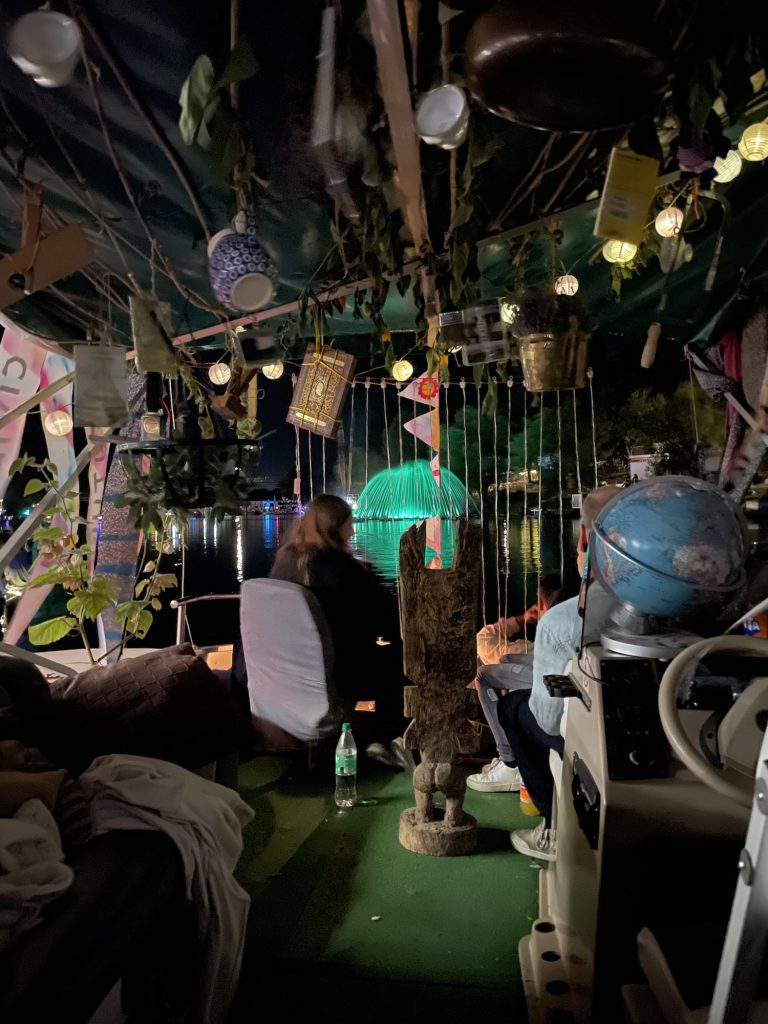
The Boat to the Future: Vessel of Psychic Migration:
When it became known that Utopienale III would be held at the same time as the annual Havelberg Bootskorso (Boat Parade), the organizers made a plan to participate. The result was a boat performance on the theme of the migration of civilization into the future, the boat itself entitled “Vessel of Psychic Migration.” With the question, “What is essential to civilization?” foremost in mind, a floating installation, with video, sound, and illumination was produced. Local high school students were invited to participate in workshops to help determine the focus and produce the installation itself. Posed with the question, “What is important for you about the future of civilization,” they were asked to paint flags and pennants to transform the boat in response. Some were visual, some textual. The students were encouraged to participate in all aspects of the preparation and the Bootskorso performance itself.

Drawing on the intriguing and idiosyncratic library and collection at the Old School, Utopienale co-director/curator Azby Brown selected artifacts and texts which held promise as embodiments of civilizational necessities. Objects and books were chosen that both symbolize and physically exist as human cultural phenomena: A candle with a burning flame is energy; living tomato, olive, eggplant, and basil plants are food; carpentry implements are tools; a length of rope makes connections; a Chinese ink, brush, and paper set is a means of communication; a volume of Thomas Moore’s Utopia shares visions of what does not yet exist but could; an antique edition of Shakespeare is the transmission of knowledge over a span of time measured in centuries; a miniature bronze statue embodies the protection of children; medicinal herbs embody the ability to heal; an old pitcher is a vessel for holding the formless; an antique African votive carving is magic. These and other items were suspended simply from the roof of the boat, which had been refashioned out of living saplings covered with leaves. Others were placed on the deck. An LED light array was programed to display texts posing questions about the future and a pair of eyes, suggestively looking for a path forward.
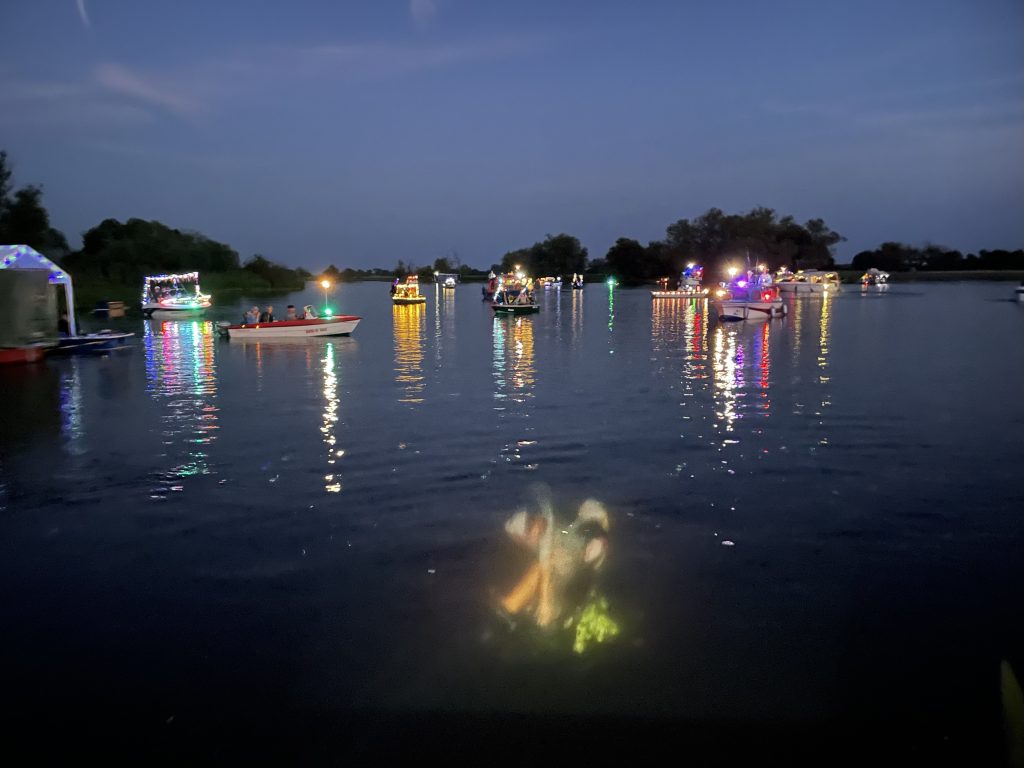
From the start it was considered essential that the boat have a means to project images on its surroundings. The question of what kind of images were needed was answered when the Dutch artist TINKEBELL. suggested making a video depicting people who had missed this boat to the future and were left floundering. TINKEBELL. and Brown enacted this scene, swimming frantically in the Havel river while fully clothed, a suitcase in his hand, a basil plant in hers, while a drone overhead captured the video. During the Bootskorso, this performance-in-a-performace, titled, “But we’re supposed to be on the boat!” was projected onto the river’s surface from the rear of the boat. It captures with heavy irony the shock of the entitled who have always expected they would be taken care of despite their own refusal to contribute or prepare. TINKEBELL.’s basil plant was later suspended from the top of boat’s mast as a talisman for all to see. The Vessel of Psychic Migration was manned by the students themselves, and piloted by their local counselor, Dominique Jutze, who also provided needed technical assistance for video, audio, lighting, and construction. Weaving its way mysteriously down the Havel River amid the dozens of garishly illuminated pleasure craft filled with noisy Bootskorso revelers, the Vessel of Psychic Migration was bemusedly celebratory and somehow calming to be aboard. Books, pottery, plants, tools, and artworks swung peacefuly overhead like poorly coordinated pendulums, as the couple left behind were never able to catch up no matter how hard they swam.
The Exhibition: Carrying civilization forward into the future
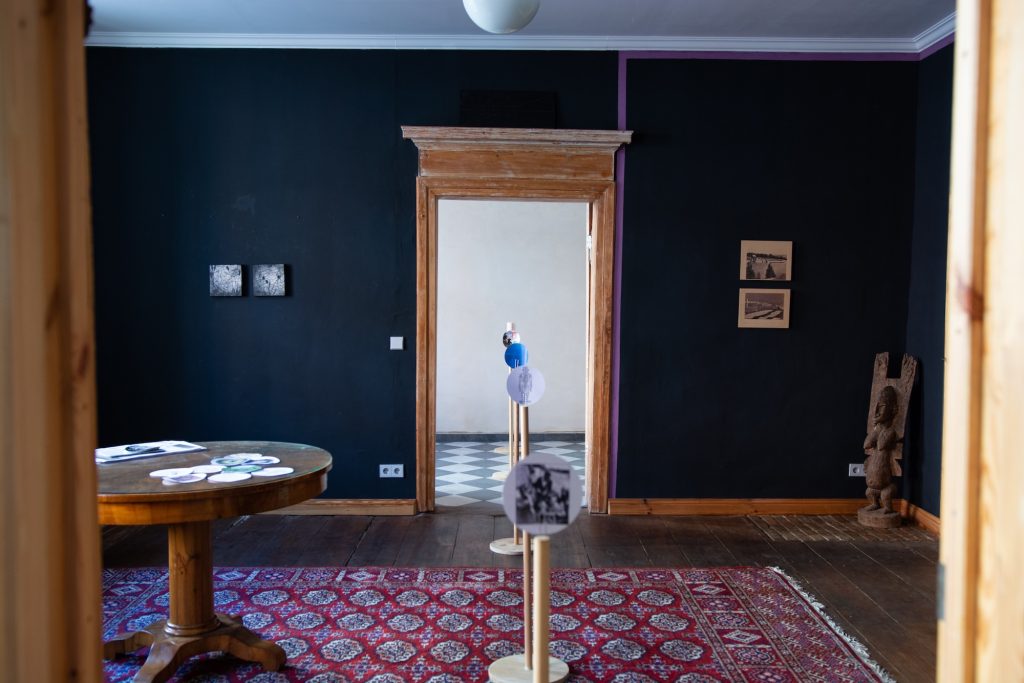
The summary exhibition is conceived of as means of furthering discussion and engagement with the themes that emerged over the course of Utopienale III. Installed across the ground-floor exhibition rooms of the Old School, it brings together three related components: the “embodiments of civilization” which were carried on the Vessel of Psychic Migration; artworks contributed by Utopienale participants; and a set of moveable wooden stands holding key objects as well as small circular images and texts about the continuation of civilization.
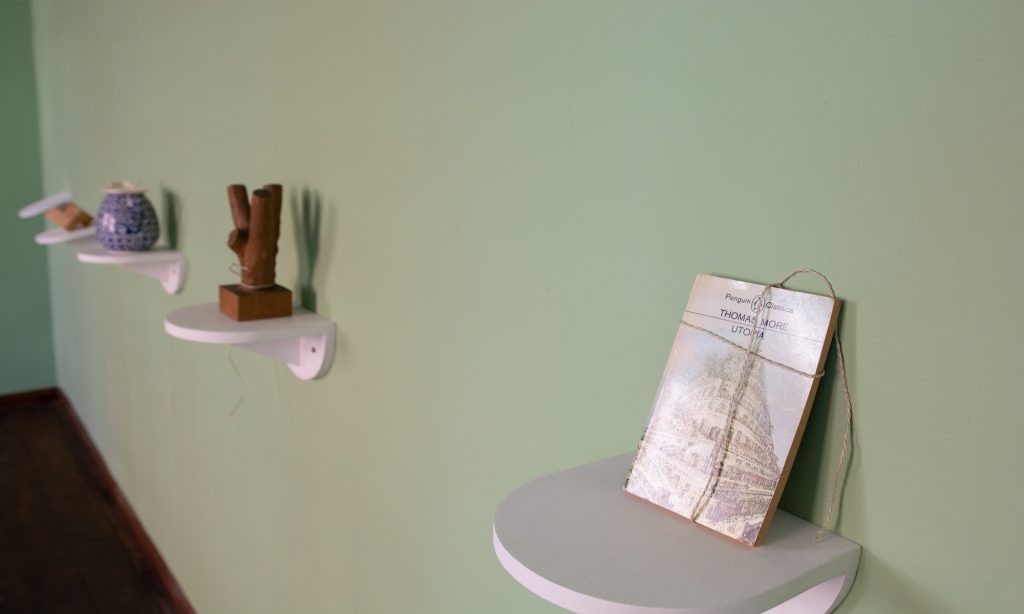
Several of the “embodiments” were selected to be placed on small wall-mounted wooden brackets. These include a paperback volume of Moore’s Utopia; a carved wooden representation of a tree with mysteriously truncated limbs by local artist Günter Klam; a small antique ceramic pitcher filled with rice; and a small work by Brown titled “Unsolvable Problem,” which takes the form of sectioned wooden cube. The bracket supporting it is tilted to a degree that the object could easily slip off, thereby embodying a precarious state. The next and final wall bracket is extrememly tilted and incapable of supporting anything. Perhaps it itself is insupportable. The strings from which these objects were suspended on the boat are still attached. Other “embodiments,” such as the antique Shakespeare volume, are displayed on tall square pedestals.
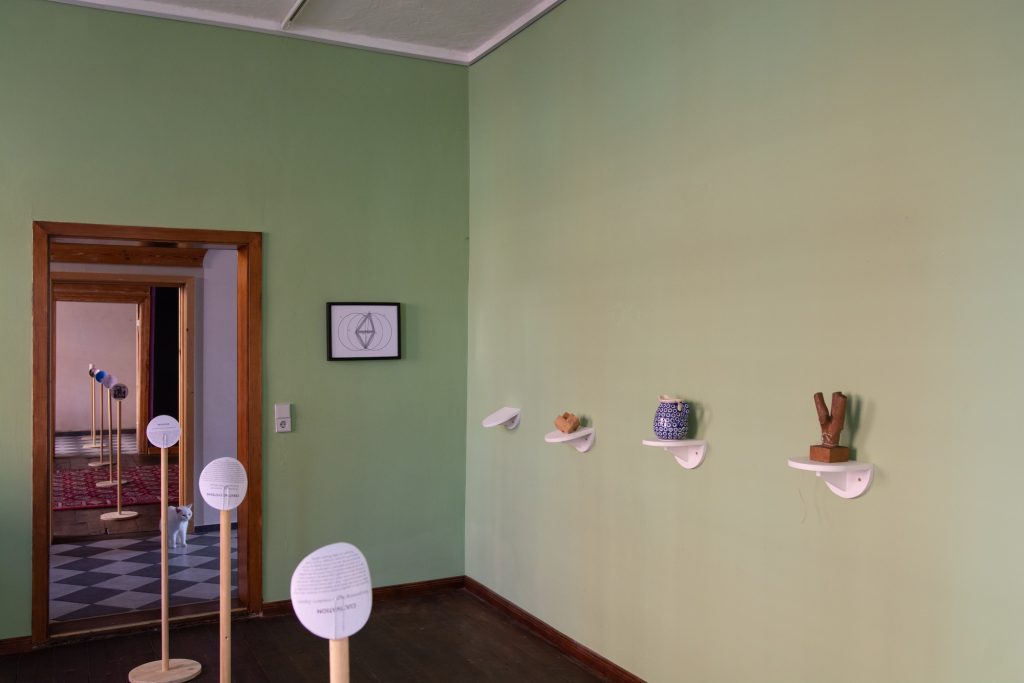
Due to its “floating” nature, invited participants to Utopienale II, which included artists, researchers, and others, drifted in and out of the Old School over the course of two weeks. They were asked to bring small artworks, texts, etc. they felt might further discussion during the conference even when they were not there personally. Seen together, these works each deal in different ways with human impacts and our self-destructive tendencies. They operate, in participant Gaston Mesken’s words, as “critical mirrors,” both posing and replying to the questions, “Where are we and how did we get here?”
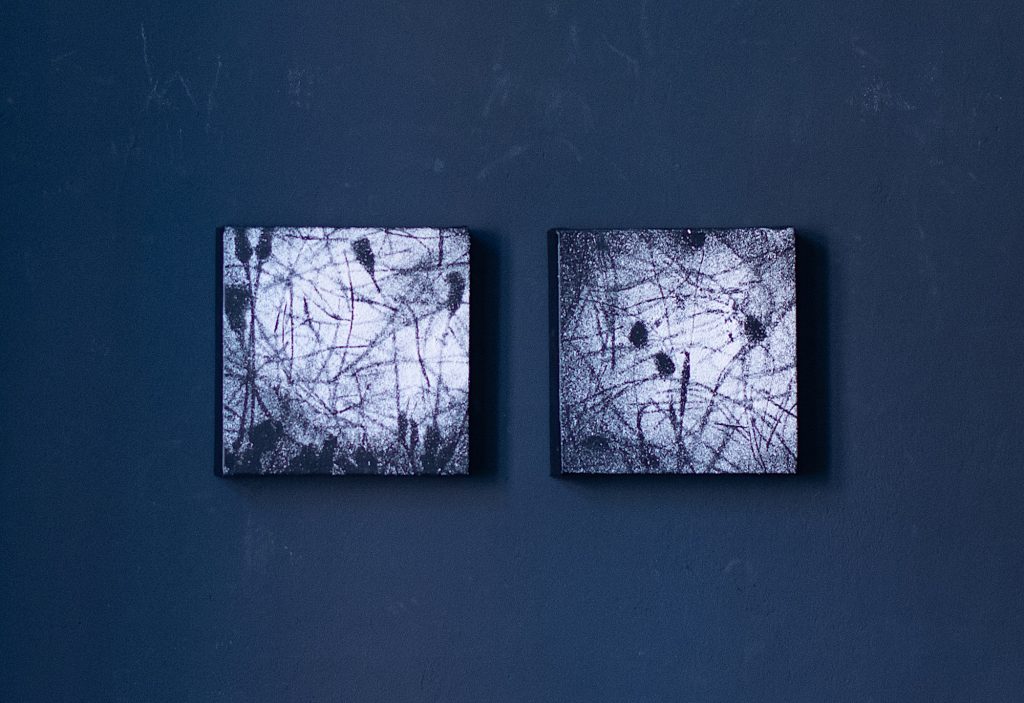
TINKEBELL. contributed a pair of small works on canvas from her Arena Candidus Solvay series, in which white soda-ash industrial pollution from an afflicted but incongrously beautiful beach in Tuscany has been sprinkled over vegetation gathered at the site and laid on black canvasses. The resulting images are reminiscent of photograms, the shadows of leaves, stems, and pine needles remaining shadowy black against the hazardous granular white ash. Meskens, who is a philosophical activist and artist with a background in nuclear physics, is represented by two intriguing prints on MDF boards titled The Barrage I & II (out of a series of 5). Created using an inkjet-based monotype technique he developed, these are delicate monochrome photographic images of the environment near hydroelectric dams, where nature gives way to human intervention. Characteristically unnatural natural environments, they hint at a world both with and without mankind. Student Jona Kollrich’s humorous photograph of TINKEBELL. and Brown’s performance, “But we’re supposed to be on the boat!” is also displayed.

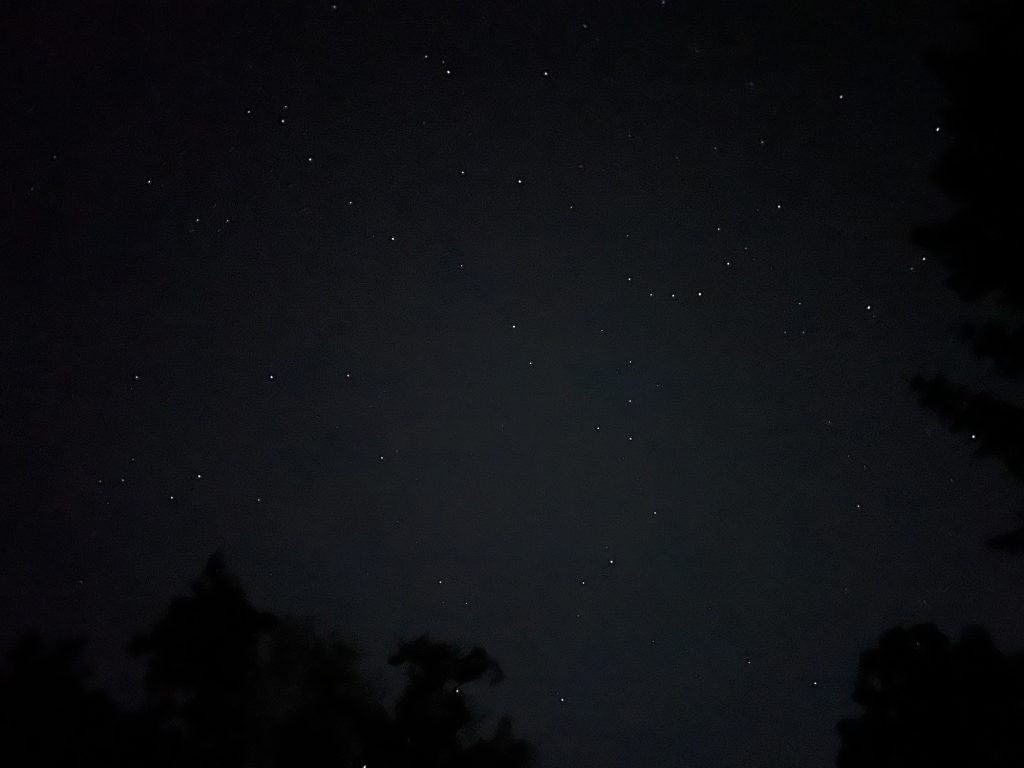
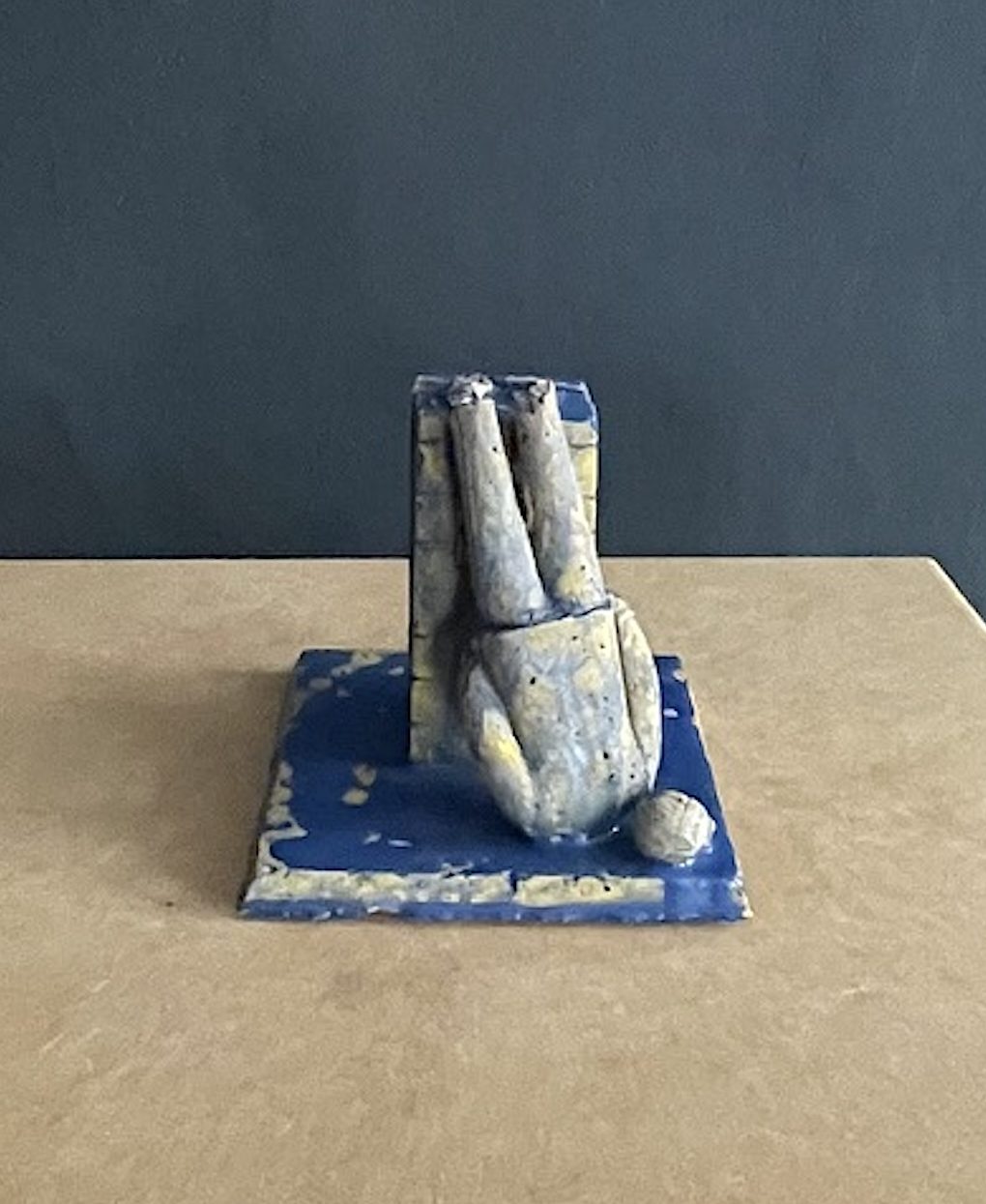
Georgian sculptor Lado Khartishvili lent a small ceramic sculpture titled Pyramide, which depicts a monumental statue of an authoritarian leader having fallen from its high plinth. “Blackout Skies in the Total War, 2024,” is one of a series of photographs by Ukrainian environmental activist Pavlo Tkachenko depicting the night sky over his home in Dnipro during a blackout caused by Russian destruction of energy infrastructure. Two large inkjet prints by Brown are also included. Inspired by food safety concerns following the Fukushima Disaster, “Potatoes Damned to Radioactive Hell” from 2020 densely overlays images of a human figure, earthquake rubble, an illustration from Diderot’s Encyclopedié, McDonald’s Mayor McCheese, and other items, overlain by a botanical drawing of a potato plant rendered in bright green. A related work, “Gertrude Stein Contemplates the Destruction of the Library of Alexandria” repurposes several of the same elements, here combined with an AI-generated image of Stein as Athena, in the style of Giambattista Tiepolo.
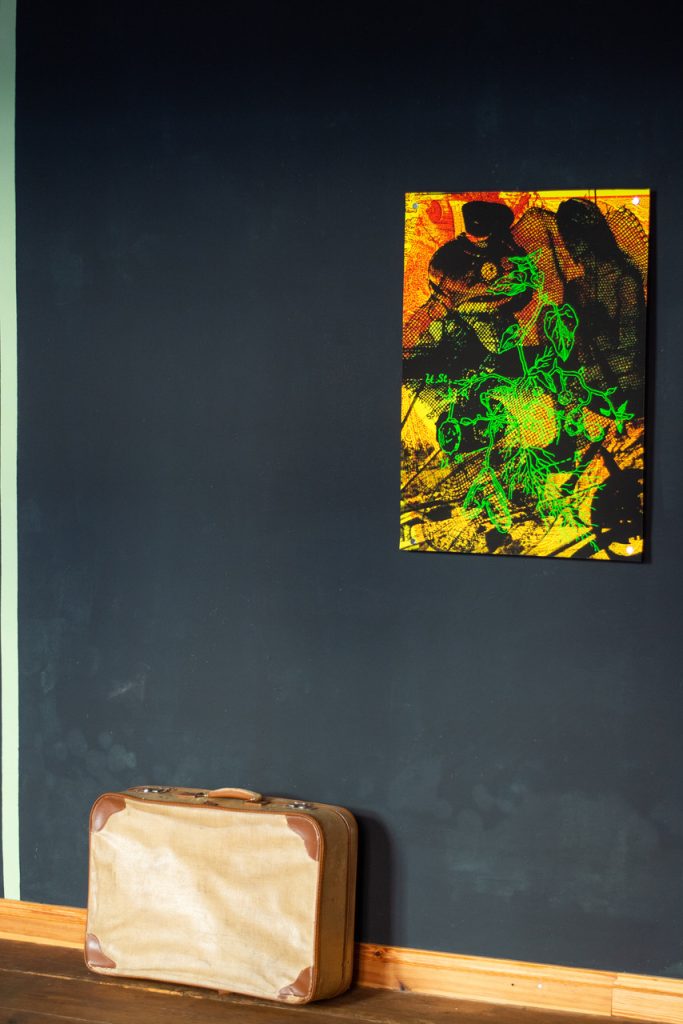
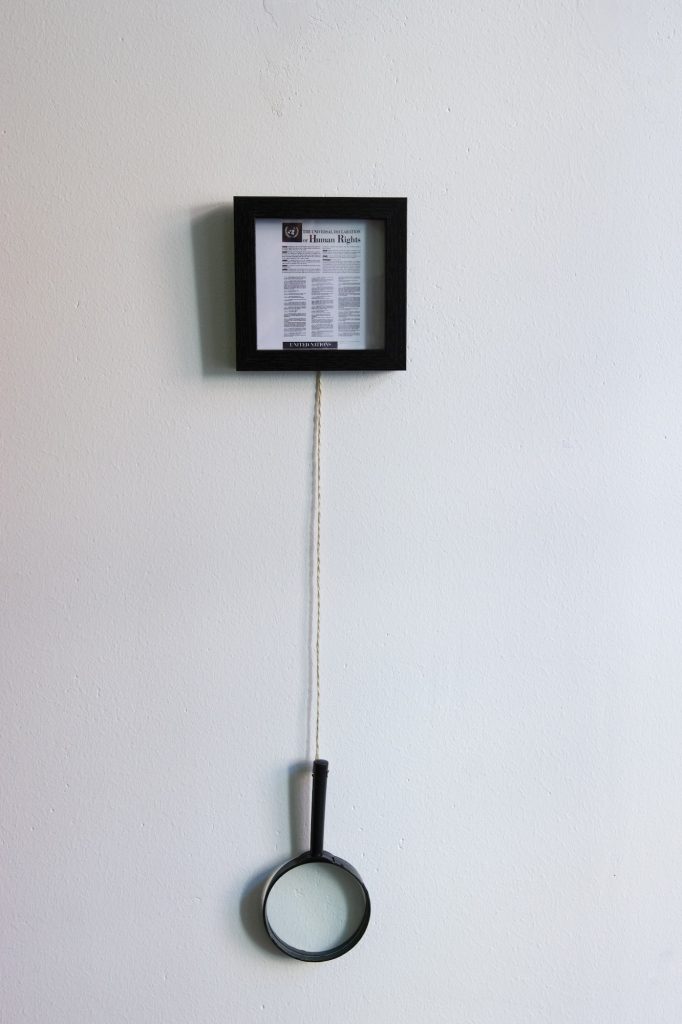
“The Universal Declaration of Human Rights, Sadly Diminished,” was prompted by TINKEBELL.’s initiation of discussion about the importance of carrying forward to the future effective codification of human rights. The Universal Declaration established an extremely strong basis for protecting human rights in 1948, but despite its promise and continuing validity and relevance, at this point we can only lament its failure. Sadly Diminished presents the opening page of the declaration in miniature, readable only with the help of an attached magnifying glass.
These are all critically provocative works, some humorously or ironically framed, all socially, politically, and historically probing. They represent the cautionary foundation of the Utopienale project regarding civilization.
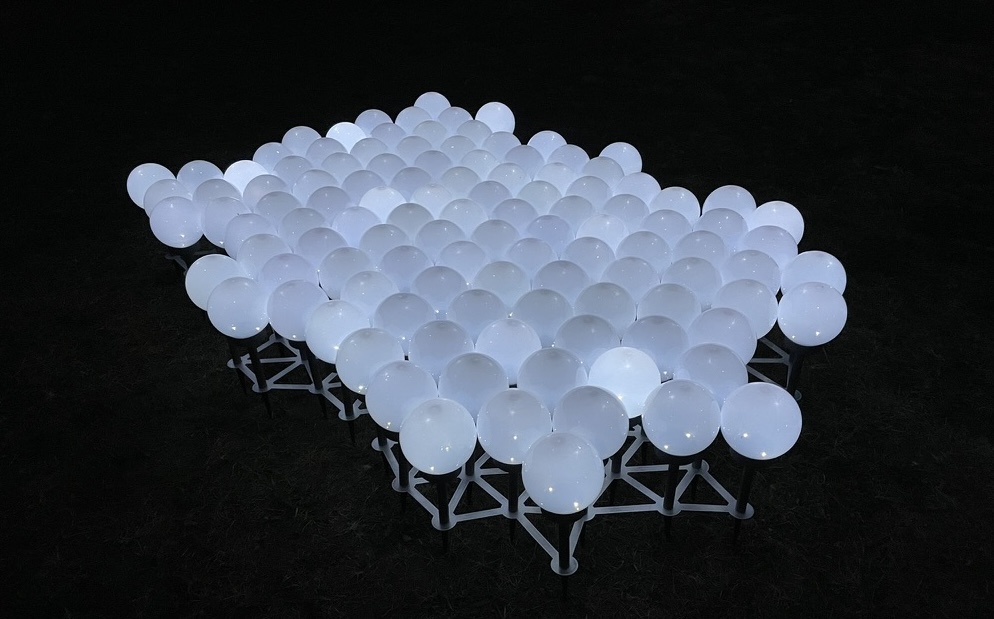
Other works on exhibit seek to suggest ways forward. One is Meskens’ hand-annotated printed diagram titled “A Topology of Agency.” Part of a larger project that seeks to reformulate humanist values with the goal of nurturing self-critical world citizens, it is nonetheless enigmatic. The scheme represents possible artists’ positions, with the arrows and scales suggesting a kind of ‘scientific way’ to represent them. Ultimately it encourages us to derive our own conceptual frameworks. A geometric construction by the Viennese artist, composer, and mathematician Hofstetter Kurt is similarly abstract. In “Construction of the golden ratio in five steps with compass and ruler,” from 2005, Hofstetter finds a simple means of deriving of the golden section by elaborating on a diagram from Euclid’s “Elements – Propositio 1 / book 1.” Euclid’s work is a notable example of tools bequeathed to us by ancient ancestors — here mathematics and geometry — that remain valid and useful. By expanding on Euclid’s construction, Hofstetter demonstrates that civilizational concepts like these remain alive across deep time, and that we can in fact improve on them and in turn pass them forward into the future. Hofstetter’s geometric construction had great implications for the generation of aperiodic patterns of irregular hexagons, and is the core concept behind his outdoor light sculpture Singular Field II (2024) on display during the Utopienale.
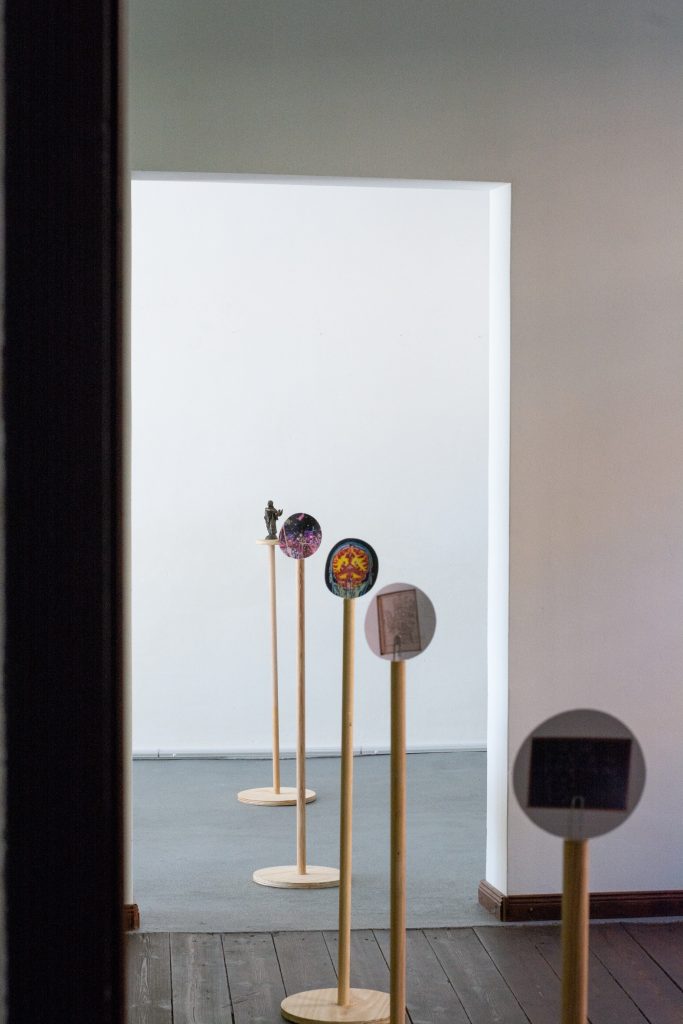
The stands
20 simple wooden stands capable of holding images or objects are placed in a way that unites the separate exhibition rooms and encourages people to move through them. Initially placed in a single line extending throughout the ground floor of the Old School, they are designed to be moved and repositioned by visitors. Relevant images and texts are printed on small circular disks, and additional printed material and blank disks are provided so that visitors can add to or reorder the content. Although the original linear layour suggests a timeline of civilization over the ages, it is not. Instead, it is a means of presenting a progression of priorities as we consider which aspects of civilization to bring forward into the future. At one end a small bronze statue is placed. This artwork, tentatively atrributed to the French sculptor Antoine Bourdelle (student of Auguste Rodin and teacher of Giacometti and Matisse), it depicts a female figure in Biblical dress protectively holding an infant at arm’s length. The subject may be the Judgement of Solomon perhaps, or the Massacre of the Innocents, this particular figure possibly being part of a larger tableau. For our purposes it represents the protection of children, the primary condition for the continuation of the species. The stand at the opposite end of the exhibition space holds a candle engraved with a scale of horizontal lines so that the passage of time can be gauged as it burns down. Like the bronze miniature it is suggestive of religious practice, but is not religious, instead being humanizing in intent. Both of these items were carried on the Vessel of Psychic Migration as essential embodiments of civilization.
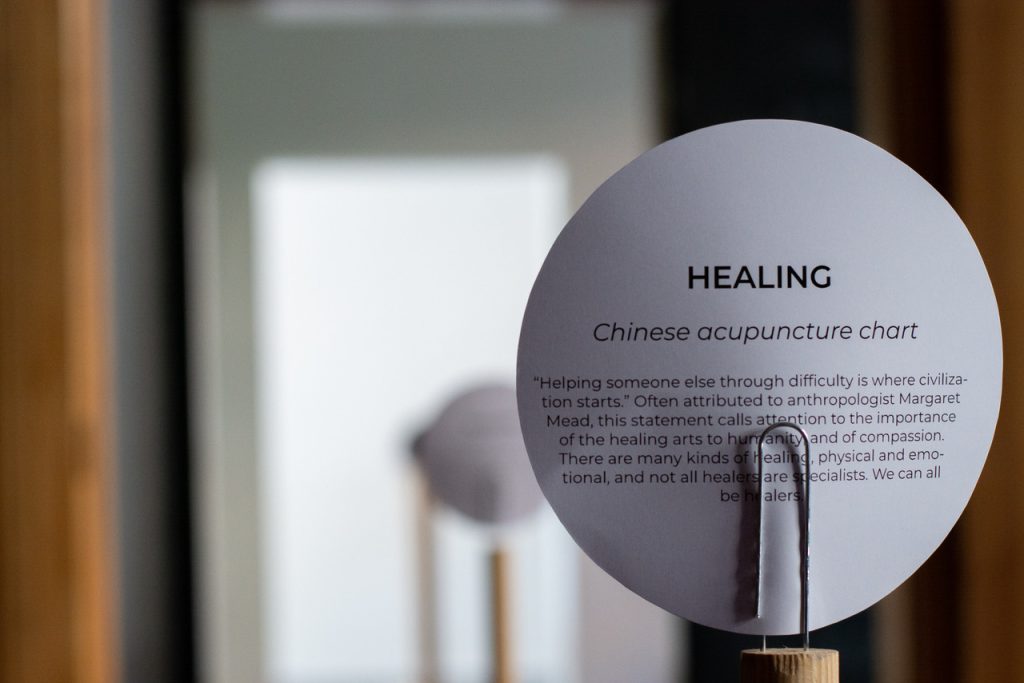
The printed disks were devised and made at the very end of the Utopienale. Each has a representative statement on one side and and image on the other. Taken together they attempt an argument about key aspects of civilization we should seek to see continued, and capabilities we should emphasise in order to achieve that. They include:
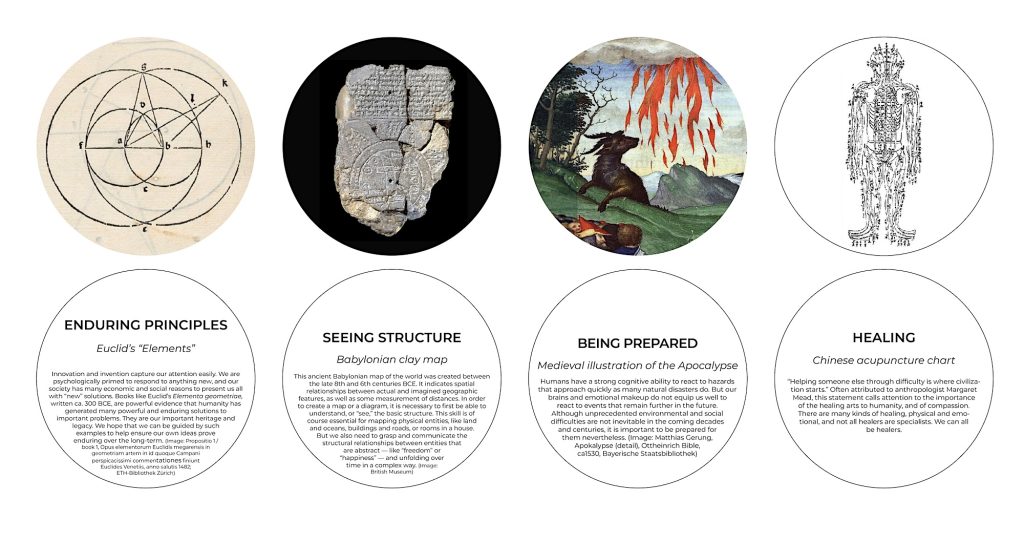
Healing, Teaching, Governance, Notation, Taking time to notice, The time-scale of trees, Our wonderful hands, Creating systems, Visualizing the future, Planning, Seeing structure, Being prepared, Direction, Expertise, Cultivation, Knowing ourselves, Nurturing, Living together, Celebration, Enduring principles
Again, because this list can never be considered complete, the exhibition system encourages amendment and addition by visitors. This list and index can take many forms and can be shared in many ways, and is expected to grow and develop over time.
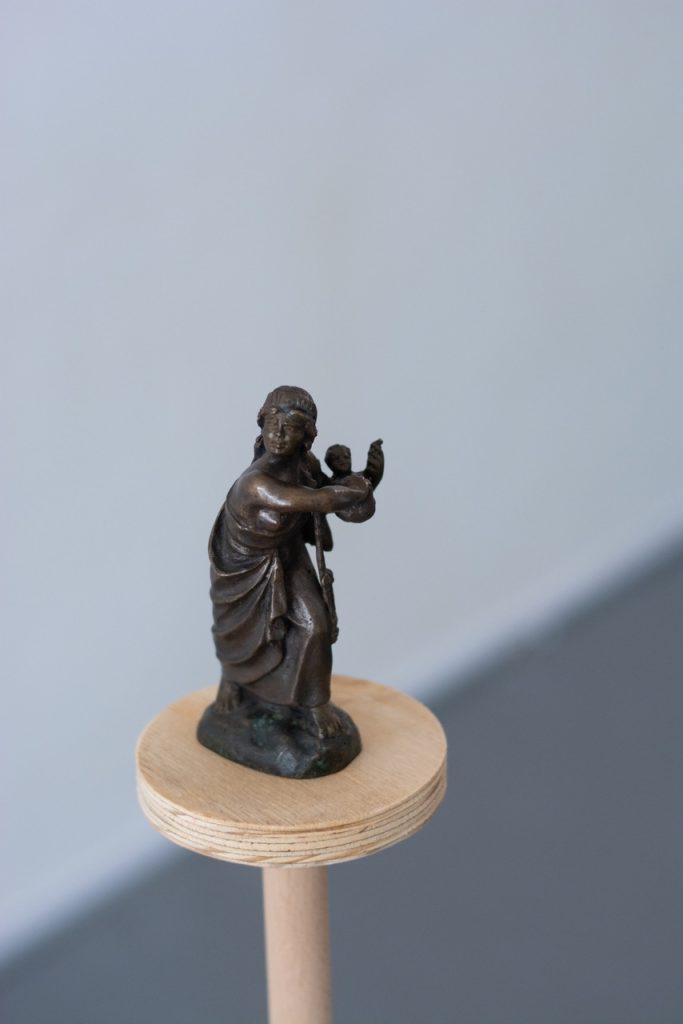
Conclusion:
UTOPIENALE III: Carrying civilization forward into the future was an engaging and fulfilling flow of activities and conversation. Because the organizers saw the need for it to be as open-ended as possible, we embraced its “floating” aspects. At the same time, the welcoming nature of the Old School kitchen and its ample table provided a well-grounded base of activity. Truly unpredictable beauty was able to emerge. Our theme of civilization is dauntingly broad, and is rarely confronted as directly in an artistic context as it was here. Like the majority of citizens, most artists seem to have their hands full just dealing with immediate concerns. As one student workshop participant remarked, “I don’t think much about the future because it makes me sad. It’s much better for me to focus on now.” In a time when the previously unimaginable happens with alarming frequency this is an entrely understandable and valid human reaction. We are made to feel small and helpless against vastly influential entities that direct our governance but do not share our sense of responsibiity for stewardship and transformation. And yet we continue to believe that art has emancipatory potential, that it can help us become long-term thinkers and Good Ancestors, to visualize and plan for desirable realities that don’t exist yet, but might.
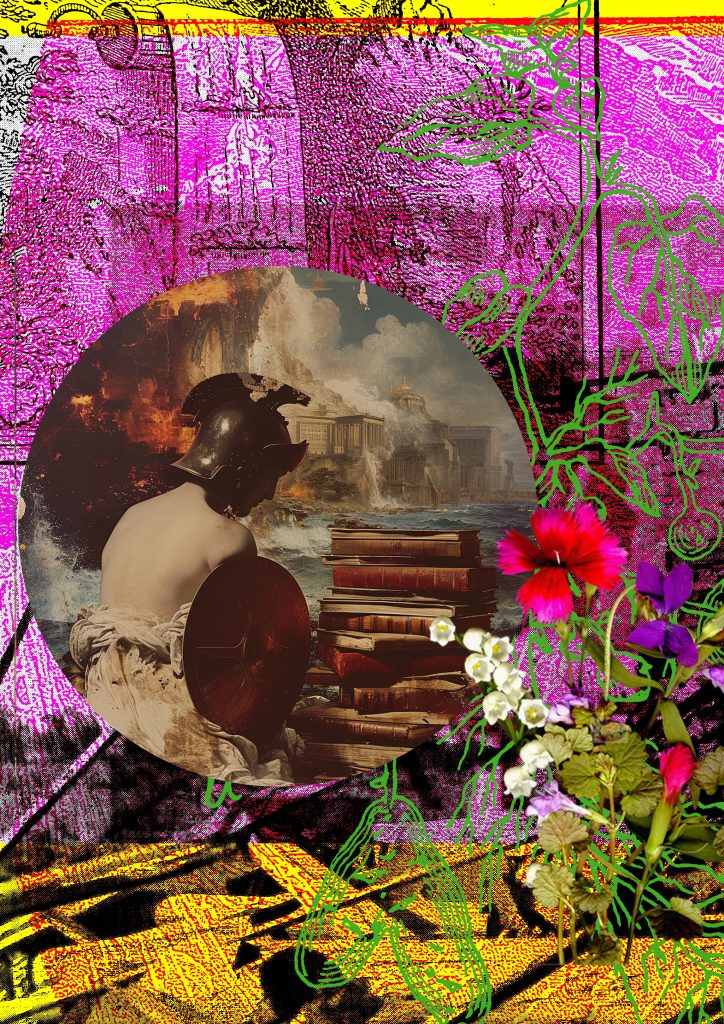
SUMMARY
Dates: August 30 – September 1, 2024
Location: Old School ICA, Havelberg, Germany
Organizers: Azby Brown, Anke Leonhardt & Wolf Guenter Thiel
Participants: Azby Brown, Hofstetter Kurt, TINKEBELL., Gaston Meskens, Johanna Fick, Takwe Kaenders, Anke Leonhardt, Wolf Guenter Thiel, Sergej Gladkich, Lado Karthishvili, Arif Amirov, Dana László da Costa, Gerald Kofler, Heidulf Gerngross, Michelle Schreiner, Zwantje Beer, Kira Klein, Jiamu Yang, and others.
(This text previously appeared in FAIR magazine, 01/2025)
